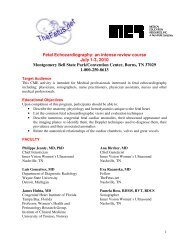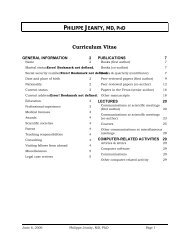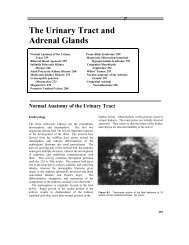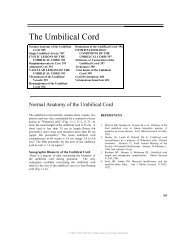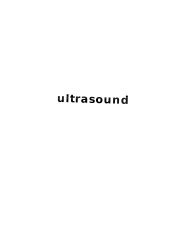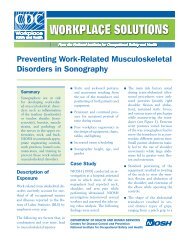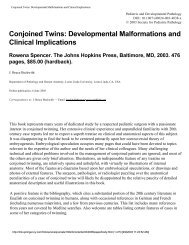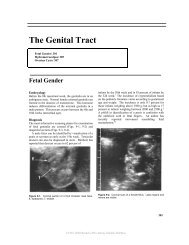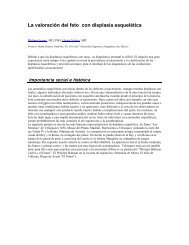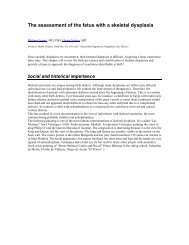Vasa previa - SonoWorld
Vasa previa - SonoWorld
Vasa previa - SonoWorld
Create successful ePaper yourself
Turn your PDF publications into a flip-book with our unique Google optimized e-Paper software.
<strong>Vasa</strong> <strong>previa</strong><br />
Finally, a vessel seen during a first trimester transvaginal<br />
scan should not be assumed to represent a vasa<br />
<strong>previa</strong>. Too often the vessel will be of maternal origin<br />
and be confused because of lateral resolution issues.<br />
Pulse Doppler will demonstrate a maternal pulse. The<br />
diagnosis of vasa <strong>previa</strong> is thus best made in the 2nd to<br />
3rd trimester. Should a suspicious vessel be found in the<br />
first trimester, a repeat scan in the second trimester is<br />
suggested.<br />
Review of the literature is provided in Tables I and II.<br />
Since vasa <strong>previa</strong> have been considered difficult to diagnose,<br />
have not specifically been sought and are not<br />
common, there are unfortunately no large prospective<br />
studies of the condition, and the evidence about the<br />
benefit of antenatal diagnosis relies on many small series<br />
or case report.<br />
Associated anomalies<br />
The various reported associated anomalies are probably<br />
coincidental and include cephalocele (38), Scimitar<br />
syndrome (36) and Trisomy 21 (38). A few others can be<br />
related to compression or damage of the vessels by the<br />
presenting parts and includes heart rate anomalies (43),<br />
small for gestational age, and intra-ventricular hemorrhage<br />
in a twin or even intra-uterine fetal death (23).<br />
Prognosis<br />
The major complication from vasa <strong>previa</strong> is the rupture<br />
of the vessels carrying fetal blood. This occurs at or near<br />
delivery if the condition is undetected. These results in a<br />
perinatal mortality of 56% (56) in undiagnosed cases,<br />
and 3% in those diagnosed prenatally (56). The median<br />
Apgar score (1 and 5 min) is 8 and 9 when detected prenatally<br />
versus only 1 and 4 for survivors of undetected<br />
cases (56). Further, transfusion is required in 58% of<br />
newborn without prenatal diagnosis, versus only 3% of<br />
those diagnosed prenatally (56). A less well quantified<br />
complication is the compression of the vasa <strong>previa</strong> by<br />
the presenting part resulting in decreased flow to the fetus<br />
and possibly hypoxia (57). Postnatal complications<br />
are related to either prematurity (due to early C-section<br />
with no confirmation of lung maturity) and include hyaline<br />
membrane disease, bronchopulmonary dysplasia,<br />
transient tachypnea, respiratory distress syndrome, or<br />
to partial exsanguination and complications related to<br />
anemia, hypovolemic shock (23) or complications of<br />
transfusions (8).<br />
Recurrence risk<br />
No reported increased risk.<br />
Management<br />
The outcome is markedly improved (97% survival versus<br />
44%) when a prenatal diagnosis is followed by elective<br />
C-section is performed at 35 weeks or earlier if<br />
signs of labor or membrane rupture occurs (56). Some<br />
have advocate hospitalization from 30-32 weeks with<br />
corticosteroids to assist in promoting lung maturity when<br />
the cervix is not demonstrated to be long and closed<br />
(58). When time permits, an amniocentesis to assess<br />
lung maturity is justified (59).<br />
Advocacy<br />
In the UK – UKVP raising awareness (http://www.vasapraevia.co.uk)<br />
has been very active in raising awareness<br />
on the issue (and their originators Daren & Natalie<br />
Samat deserve a lot of credit for their tireless work). The<br />
authors express their gratitude for their work and of the<br />
work of the International <strong>Vasa</strong> Previa Foundation<br />
(http://www.IVPF.org). Further, Dr. Oyelese has had the<br />
great kindness to review this manuscript and his many<br />
corrections are greatly appreciated.<br />
Conclusions<br />
Although no large-scale prospective studies are there to<br />
support these conclusions, personal experiences, case<br />
reports and smaller studies all concur to demonstrate a<br />
marked improvement in outcome when a vasa <strong>previa</strong> is<br />
detected prenatally. The obvious conclusion, until<br />
proven otherwise, is that a substantial improvement in<br />
outcome will depend only on prenatal detection. This implies<br />
a greater awareness of the condition and an effort<br />
at detecting it. The purpose of this manuscript is to help<br />
alert those who do prenatal examination that vasa <strong>previa</strong><br />
are not difficult to recognize when sought and that<br />
they are common enough to be worth seeking.<br />
References<br />
11. Lobstein J. Archives de L’art des Accouchements 1801;<br />
Strasbourg; p. 320.<br />
12. Gianopoulos J, Carver T, Tomich PG, Karlman R, Gadwood<br />
K. Diagnosis of vasa <strong>previa</strong> with ultrasonography.<br />
Obstet Gynecol 1987 Mar;69(3 Pt 2):488-91.<br />
13. Oyelese KO, Turner M, Lees C, Campbell S. <strong>Vasa</strong> <strong>previa</strong>:<br />
an avoidable obstetric tragedy. Obstet Gynecol Surv 1999<br />
Feb;54(2):138-45.<br />
14. Strassmann P. Placenta <strong>previa</strong>. Arch Gynecol 1902;<br />
67:112.<br />
15. Oyelese Y, Chavez MR, Yeo L, Giannina G, Kontopoulos<br />
EV, Smulian JC, Scorza WE. Three-dimensional sonographic<br />
diagnosis of vasa <strong>previa</strong>. Ultrasound Obstet Gynecol<br />
2004 Aug;24(2):211-5.<br />
16. Francois K, Mayer S, Harris C, Perlow JH. Association of<br />
vasa <strong>previa</strong> at delivery with a history of second-trimester<br />
placenta <strong>previa</strong>. J Reprod Med 2003 Oct;48(10):771-4.<br />
17. Lee W, Kirk JS, Comstock CH, Romero R. <strong>Vasa</strong> <strong>previa</strong>:<br />
prenatal detection by three-dimensional ultrasonography.<br />
Ultrasound Obstet Gynecol 2000 Sep;16(4):384-7.<br />
18. Fung TY, Lau TK. Poor perinatal outcome associated with<br />
vasa <strong>previa</strong>: is it preventable? A report of three cases and<br />
review of the literature. Ultrasound Obstet Gynecol 1998<br />
Dec;12(6):430-3.<br />
19. Francois K, Mayer S, Harris C, Perlow JH. Association of<br />
vasa <strong>previa</strong> at delivery with a history of second-trimester<br />
placenta <strong>previa</strong>. J Reprod Med 2003 Oct;48(10):771-4.<br />
Journal of Prenatal Medicine 2007; 1 (1): 2-13 11



